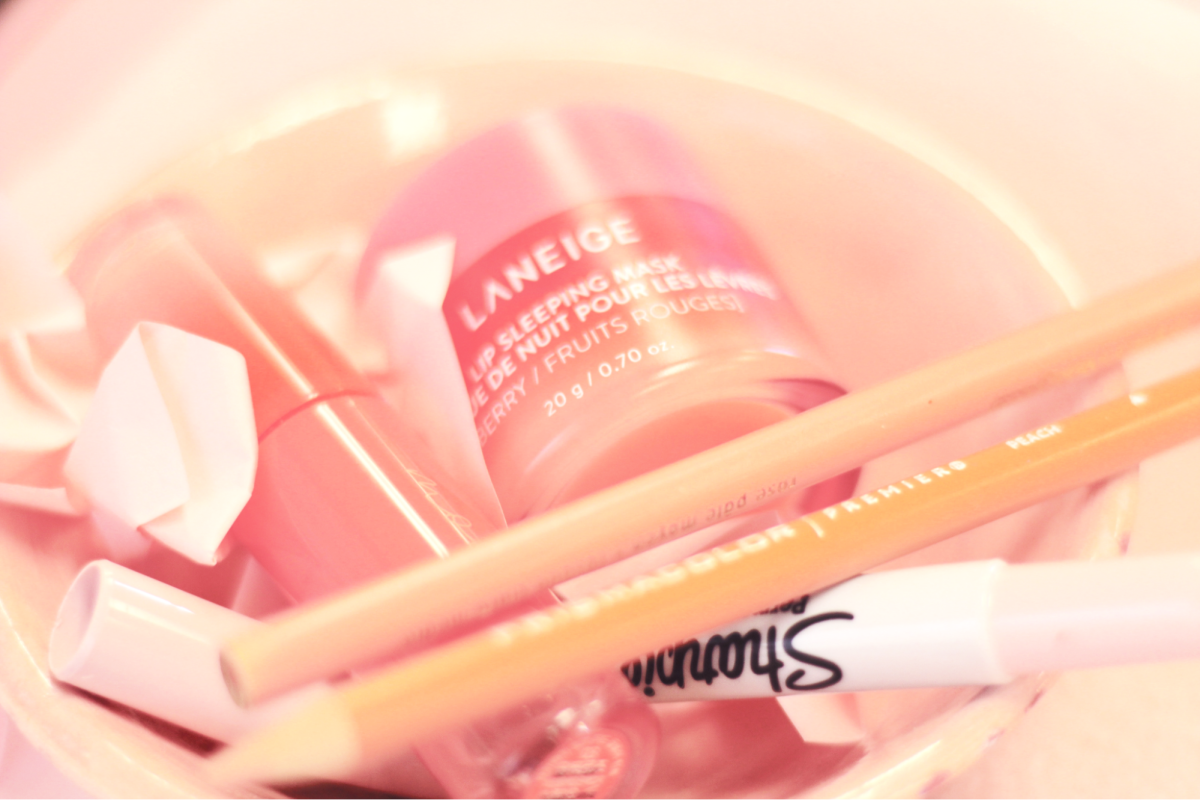On Dec. 7, 2023, Pantone announced the 2024 Color of the Year: Peach Fuzz. Unlike previous bold colors like Viva Magenta (2023) and Very Peri (2022), PANTONE 13-1023 Peach Fuzz is a much softer, pinkish-orange hue. Originating in 1999, Pantone launched the Color of the Year program in an effort to connect the world, express global culture and bring about worldwide discussions through color.
Pantone chose Peach Fuzz to express the world’s desire for closeness and connection. In the fast-paced modern age of innovations and external achievements, it’s important to take the time to nurture and have the strength to enjoy life. The gentle, comforting pink-orange shade serves as a reminder to take care of ourselves and each other through compassion.
Besides the meaning of Peach Fuzz, the process of selecting the Color of the Year is through a team of color experts that examine color’s recent influence around the world: films, fashion, trends and technology. In a similar manner, senior Neil Dhiman — the founder and president of Fashionistas of Parkway West — runs a space where like-minded fashionistas can discuss, showcase and learn more about color’s effect on fashion.
“Peach Fuzz is a really warm and luscious color. When I think of Peach Fuzz, I think of beaches, the ocean and warm sand,” Dhiman said. “The role of color in fashion would be to illuminate. [Color] provides the context and depth of fashion. Basically, it provides a general appeal to the mind. Without color, you would not be able to have fashion in itself. There would be no real clothes.”
Already, Peach Fuzz is a rising trend and many celebrities have incorporated Peach Fuzz into their outfits. At this year’s GRAMMYs, rapper and singer Doja Cat wore an eye-catching sheer peach gown. Most recently, actress Brie Larson garnered attention for her stunning peach blush-toned dress at the SAG Awards. Seeing numerous celebrities shine a spotlight on various peach hues, fashion teacher Kristen Naeger thinks that Peach Fuzz is a color that can appeal to anyone.
“We’ve seen a lot of softer tones. [In recent trends,] we’re seeing a lot of muted pinks, purples, oranges and cream colors. If pastels look good on you, [Peach Fuzz] is going to be a great color for you. Even if you enjoy bolder colors, it’s a fairly versatile color,” Naeger said.
Although bold colors have been the trend in recent years, soft colors like Peach Fuzz were once spotlighted in design. After the end of World War II, the 1950s experienced a global attitude shift to a more optimistic one. This common mindset was expressed through the light, dreamy colors of mint green, baby blues, light pinks and peach tones that dominated culture at the time. Especially in America, as soldiers returned home and started new families, young housewives started wearing pastels to convey youth, warmth and joy.
“[Peach Fuzz] is a recurring trend that’s been revived. In the ‘50s to ‘70s, all the clothes were in [Peach Fuzz],” Dhiman said. “In modern times, post-2020s, younger generations are adopting this movement called retro-fashion. Especially this year, I would see this color being really common. I definitely think that [Peach Fuzz] is a perfect choice for a color of the year.”
However, as quickly as trends are to bounce back, they are just as quick to leave. This is seen often in the fast fashion industry where clothing styles based on trends become outdated and irrelevant almost instantaneously. In comparison to fashion, a single artwork and artist can continue to hold importance for centuries. For example, Leonardo da Vinci’s “Mona Lisa” has continued to be popular throughout time no matter what the current fads are. So, while momentary color trends, like Peach Fuzz, can be important in fashion, art teacher Ashley Drissell believes the Color of the Year does not play as major of a role in the visual art realm.
“I don’t know how much it means to us [artists] necessarily. [The Color of the Year] is more relevant in fashion where designers can tailor to seasons or trends. I think visual artists have a voice and a mode of expression that’s not as changing or oscillating as a fashion designer’s might be,” Drissell said.
Besides the color’s relevancy in society, Pantone’s selection of Peach Fuzz has stirred controversies about the color resembling caucasian skin. These criticisms about the skin-like connotation originated and spread through social media like TikTok or Facebook, which is where Drissell first learned about the issue. Whether the choice has an underlying meaning, the simple color sparks necessary conversations about politics, representation and racism.
“Ever since then, I’m like, ‘yeah, you’re not wrong about that.’ I’m not sure how I feel about it. In certain circumstances, it’s tolerable, but in most cases, it’s not,” Drissell said.
But beyond discussions relating to race, the controversy surrounding Peach Fuzz could reverberate throughout various industries. With the recent push for inclusivity in makeup, the selection of Peach Fuzz as the Color of Year raises concerns that it could become a barrier for the makeup community. If companies market using Peach Fuzz, they might inadvertently market towards lighter skin tones, leaving darker shades to remain nonexistent and ignored in the industry.
However, sophomore Faith Kothe believes this connotation is too big of a stretch. Is it reasonable to hold Pantone accountable in the first place or is this peachy-swatch yet another victim of cancel culture?
“People are trying to [put it] into a bad context, [but] I don’t think it’s going to affect anything. If Pantone had chosen a darker color, would it still be the same issue? It’s a huge double standard,” Kothe said.
Despite the concerns Peach Fuzz raises, Dhiman still believes that Peach Fuzz and its intended messages of kindness can build much-needed connections and unity in this world.
“I think that the current generation is slacking on kindness. However, since the COVID-19 pandemic, there have been a lot of uplifting messages with a group mentality of ‘we are in this together,’ and this has persisted. Kindness is an essential value that will transcend generations,” Dhiman said.
Drissell also affirms that Peach Fuzz, at its core, serves as a simple reminder of kindness in a world growing cold and colorless.
“Just by suggesting that [Peach Fuzz] helps people think about or communicate kindness can cause people to contemplate that, and that’s great. It’s important especially in these times when there’s a lot of contention, tension, war and suffering to consider peace, comfort and kindness,” Drissell said. “I think we can find what we seek. I’ve seen a lot of kindness and compassion in this world; we can find compassion and kindness in this world if we seek it.”
This story was originally published on Pathfinder on February 28, 2024.






![It was definitely out of my comfort zone to get [the dress] and decide I loved it enough not to wait and risk not having something that memorable.](https://bestofsno.com/wp-content/uploads/2024/04/Precious_20180902_JRS_00008_ed1.jpg)


![Sophomore Sahasra Mandalapu practices bharatanatyam choreography in class. These new dances will be performed in an annual show in February. Mandalapu found that practicing in class helped her overcome stage fright during her performances. “When [I] get on stage, Im nervous Im going to forget, even though Ive done it for so long,” Mandalapu said. “Theres still that little bit of stage fright [when] I second-guess myself that I dont know it enough, but I do because Ive been practicing for a whole year.”](https://bestofsno.com/wp-content/uploads/2024/05/Sahasra-6-Large-1200x844.jpeg)

![In their full runway outfits, (from left) Audrey Lee 25, Olivia Lucy Teets, 25, Fashion Design teacher Ms. Judy Chance, and Xueying Lili Yang pose for a photo. All three girls made it to Austin Fashion Week by getting in the top 10 in a previous runway show held by Shop LC.
[I like my students] creativity and how they can look at a fabric and make it their own, Ms. Chance said.](https://bestofsno.com/wp-content/uploads/2024/04/IMG_9686-e1714088765730-1129x1200.jpeg)














![IN THE SPOTLIGHT: Junior Zalie Mann performs “I Love to Cry at Weddings,” an ensemble piece from the fall musical Sweet Charity, to prospective students during the Fine Arts Showcase on Wednesday, Nov. 8. The showcase is a compilation of performances and demonstrations from each fine arts strand offered at McCallum. This show is put on so that prospective students can see if they are interested in joining an academy or major.
Sweet Charity originally ran the weekends of Sept. 28 and Oct. 8, but made a comeback for the Fine Arts Showcase.
“[Being at the front in the spotlight] is my favorite part of the whole dance, so I was super happy to be on stage performing and smiling at the audience,” Mann said.
Mann performed in both the musical theatre performance and dance excerpt “Ethereal,” a contemporary piece choreographed by the new dance director Terrance Carson, in the showcase. With also being a dance ambassador, Mann got to talk about what MAC dance is, her experience and answer any questions the aspiring arts majors and their parents may have.
Caption by Maya Tackett.](https://bestofsno.com/wp-content/uploads/2024/02/53321803427_47cd17fe70_o-1-1200x800.jpg)
![SPREADING THE JOY: Sophomore Chim Becker poses with sophomores Cozbi Sims and Lou Davidson while manning a table at the Hispanic Heritage treat day during lunch of Sept 28. Becker is a part of the students of color alliance, who put together the activity to raise money for their club.
“It [the stand] was really fun because McCallum has a lot of latino kids,” Becker said. “And I think it was nice that I could share the stuff that I usually just have at home with people who have never tried it before.”
Becker recognizes the importance of celebrating Hispanic heritage at Mac.
“I think its important to celebrate,” Becker said. “Because our culture is awesome and super cool, and everybody should be able to learn about other cultures of the world.”
Caption by JoJo Barnard.](https://bestofsno.com/wp-content/uploads/2024/01/53221601352_4127a81c41_o-1200x675.jpg)





